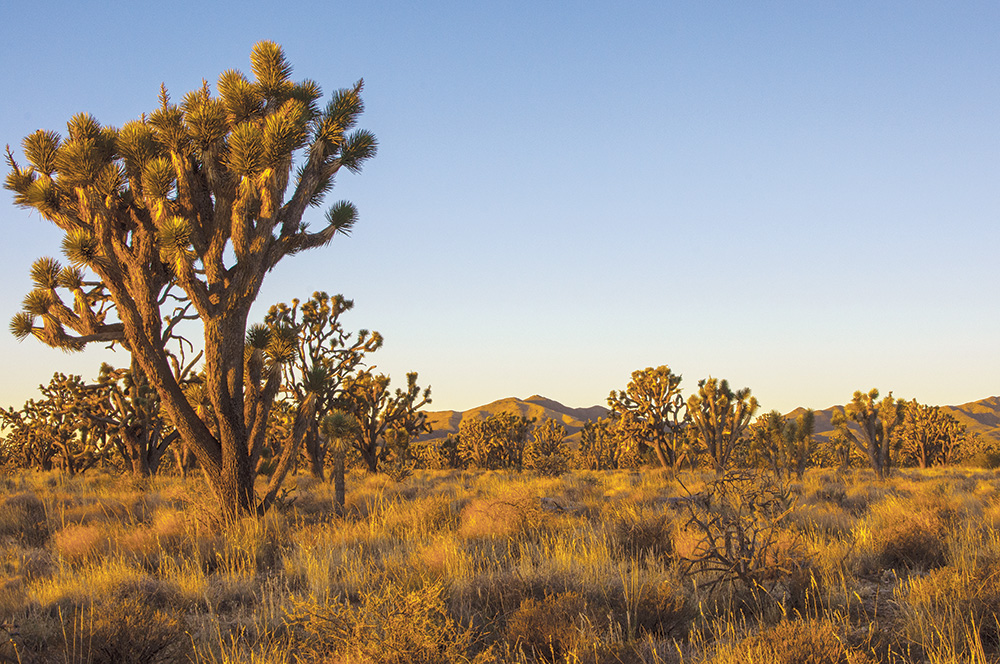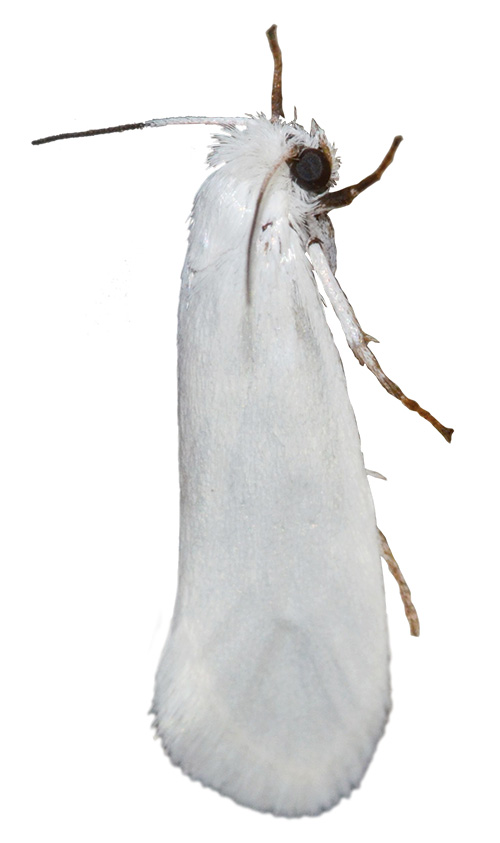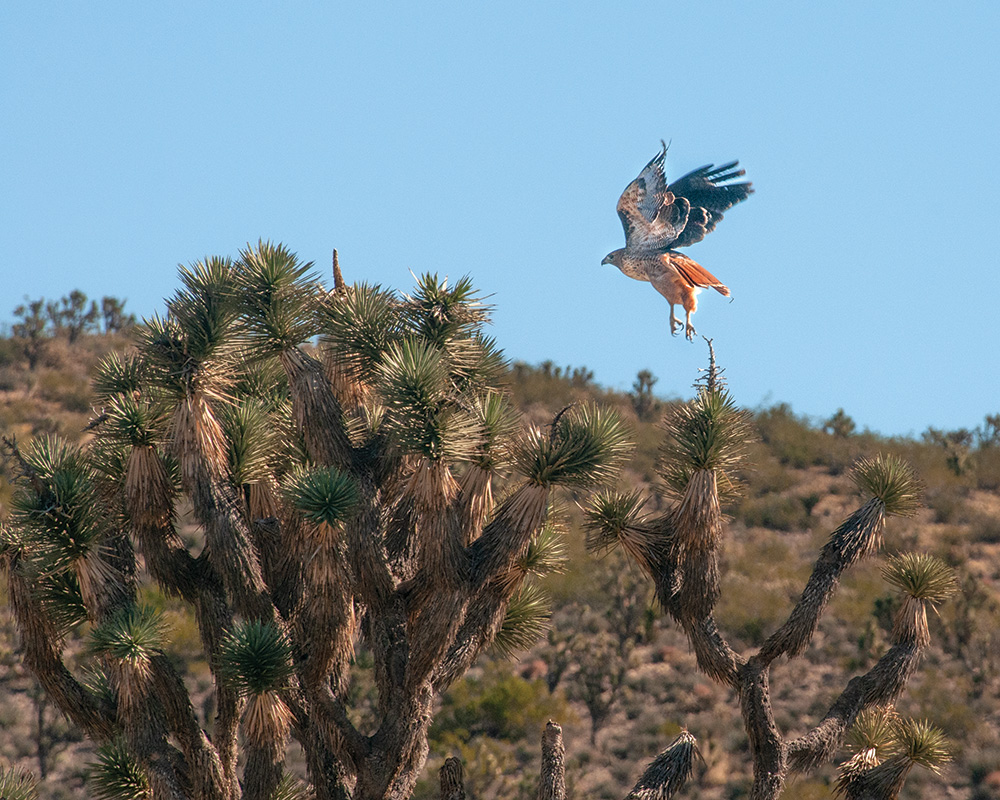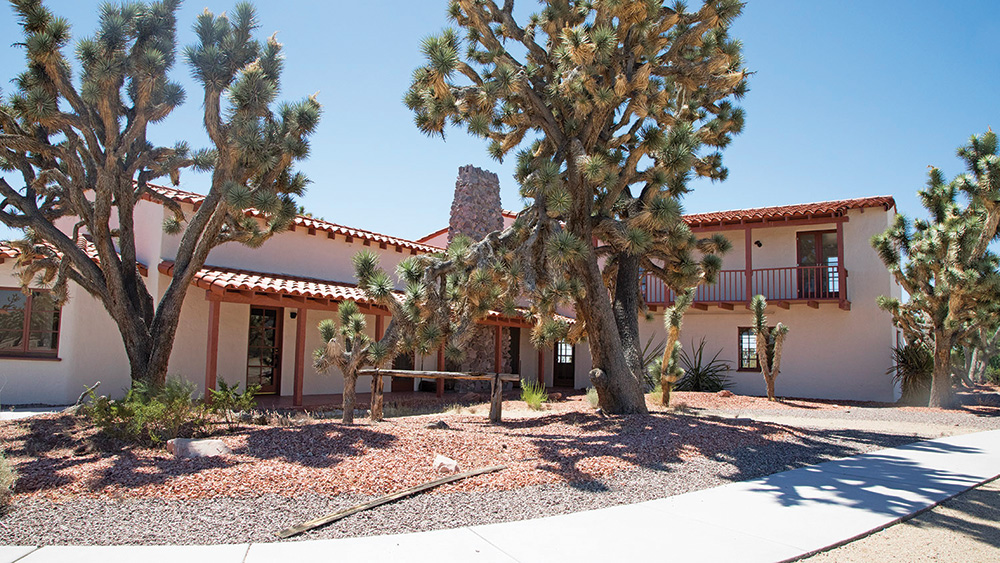Wee Thump Joshua Tree Wilderness
Fall 2022
The Mojave’s most miraculous resident thrives just over an hour south of Las Vegas.

BY MICHELE SINAGRA
 Legend has it that when Mormon settlers crossed the forbidding Mojave Desert, they found solace in the trees. The Joshua tree, with its branches reaching upward in almost human-like form, reminded them of the biblical character Joshua, who led his followers through the desert with outstretched arms pointing to the heavens in prayer. Although they thrive in the Mojave Desert, Joshua trees aren’t always easy to find. That is what makes the Wee Thump Joshua Tree Wilderness so special: for just a short stretch on a lonely highway, the conditions are so perfect that the surrounding hills are literally blanketed with them.
Legend has it that when Mormon settlers crossed the forbidding Mojave Desert, they found solace in the trees. The Joshua tree, with its branches reaching upward in almost human-like form, reminded them of the biblical character Joshua, who led his followers through the desert with outstretched arms pointing to the heavens in prayer. Although they thrive in the Mojave Desert, Joshua trees aren’t always easy to find. That is what makes the Wee Thump Joshua Tree Wilderness so special: for just a short stretch on a lonely highway, the conditions are so perfect that the surrounding hills are literally blanketed with them.
DESERT SURVIVALIST
Yucca brevifolia—otherwise known as the Joshua tree—isn’t even a tree. As a member of the yucca family, these amazing plants are only found in the Mojave Desert, which covers parts of California, Arizona, and Nevada. A Joshua tree can range anywhere from 15 feet to a towering 40 feet, and its fibrous root system can spread nearly 40 feet, enabling it to thrive in its harsh, dry environment.

Joshua trees don’t produce nectar to attract pollinators; its survival is dependent entirely on the tiny yucca moth. Built to navigate around the tough waxy foliage, yucca moths collect pollen from one part of the flower and drop it off on the female part, moving from bloom to bloom. The yucca moth’s survival is also dependent on the Joshua tree, which provides the perfect place to lay eggs on the seeds of flowers. The seeds are the yucca moth caterpillars’ only source of food. It’s through this most unique partnership that both survive in this unlikely place.
The Joshua tree mystifies year-round. Beautiful white blossoms bud in the spring, their stalwart form stands firm and green in the blasting heat of summer, and in the winter, its spike leafed foliage captures tuffs of snow.

JOSHUA TREE HIGHWAY
Often confused with the Arizona highway of the same name and overshadowed by California’s Joshua Tree National Park, Joshua Tree Highway in Nevada is unique because most people don’t know about it.
The wilderness area’s proximity to Las Vegas makes an easy day trip. Just one hour south of Las Vegas on US-95, take the exit to State Route 164 in the town of Searchlight. Like many desert highways, SR 164 gently undulates through dry washes that quickly become torrential rivers during heavy rains. It’s a desolate road, quiet and calming, that sharpens the senses, allowing travelers to absorb the fine details of the towering McCullough and Highland Mountain ranges surrounding it.
Although you can see smatterings of Joshua trees along the entire highway, it’s in the small area named Wee Thump Joshua Tree Wilderness that the concentration is remarkably high. The U.S. Congress designated the Wee Thump Joshua Tree Wilderness in 2002, and it now consists of 6,489 acres.
The Paiute named the Joshua trees “Wee Thump” which means “Ancient Ones.” With a typical growth cycle of only a half-inch per year, many of the trees in this wilderness area can exceed 30 feet in height and could be more than 900 years old.
The turnoff for Wee Thump East Road lies just 8 miles from Searchlight. The well-maintained 2-mile dirt road takes you to a parking area, where you can leave your car and enter a magical desert forest.
For those travelers who want to explore further on foot, there is the 3-mile Joshua Tree Trail, which follows an old wagon road previously used by miners. Easy slopes make for an enjoyable walk among these gentle sentinels. Pause and listen for birds, watch how the foliage of the Joshua tree glistens in the sun, revel in the stark contrast of swirling colors in the surrounding mountains against the deep blue sky, and immerse yourself in the quiet peacefulness. This is an opportunity to enjoy the desert at its best.

THE WALKING BOX RANCH
In the same area lies the Walking Box Ranch. About 7 miles from Searchlight heading west on the same Joshua Tree Highway, you’ll come upon a Bureau of Land Management (BLM) sign announcing the Walking Box Ranch. This hidden Mojave gem holds a fascinating history.
When silent movie stars Rex Bell and Clara Bow decided to wed, they quickly realized that life in Hollywood would destroy any privacy in their lives. So, in 1931, they purchased a modest plot of 400,000 acres and built the Walking Box Ranch, named after the box-like cameras used in Hollywood silent films.
The ranch consists of four Spanish Colonial style buildings with a swimming pool, tennis courts, and other luxuries to make this a perfect Hollywood getaway for such stars as Clark Gable, Carole Lombard, and Errol Flynn. Corrals and fences were built on the land, converting it into a working cattle ranch where the couple could live out their cowboy fantasies and raise their two boys away from the temptations of Hollywood.
In later years, after passing through many hands, the property ended up under the management of the BLM and is now listed in the National Register of Historic Places. Although it’s always possible to park and walk around the periphery of the fenced compound, the interior of the ranch is not currently available to visitors. There are plans to open it, so stay tuned for updates.
The Nevada desert never ceases to amaze with its hidden delights, but seldom can we experience both its awesome beauty and colorful history all in one day. This is a trip that will not disappoint.

